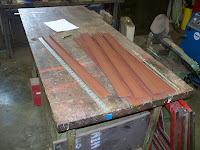Yes folks, we need a new governor. Our current governor has been wasteful and incompetent, as shown by several leaks. This puts an undue strain on the rest of the system, which can no longer be tolerated. So I say it's time for a change! First, however, we'll have to break the power of the union.
The governor, of course, regulates the air pressure in the main reservoir by turning the compressor on and off at preset values of pressure. With use, however, many of them start to leak air, and the 319's was leaking very badly. Fortunately, Bob Heinlein helped me locate a good candidate in storage, at the back of a shelf. We have a good number of these Type J governors, but most of them were already tagged as defective. We took one back to the shop and tested it on compressed air. It doesn't leak and was already set correctly, for 100/80.

Here's a Type J with the cover removed. The air portion is on the left; on the right are the electrical connections with a plunger (yellow arrow) which is pushed out rapidly when the air pressure exceeds the "off" setting. At the same time, a puff of air helps extinguish the arcs.

To the right is the far end of the air portion, showing the two adjustment cylinders for the on and off settings.

And here it is with the cover installed. By the end of the day, I was able to install the new one in the 319 and test it. It operated just as we had hoped, so this is another step forward. I'm afraid our ex-governor has been sentenced to life without parole in the dreaded "blue reefer," one of our maximum-security facilities.
I also drilled some holes to finish installing the handrails, and I attached the rope guard at the #1 end of the car.
We have been having problems with the controller at the #1 end of the 308, and also with the brake valve. I know what the problem is, but there's no way to fix it in a hurry. The blue cars are not running this weekend due to Diesel Days, but they will be the next two weekends. So the easiest way to avoid this problem was to switch positions of the two cars. I first retested the controllers, brakes, and whistles at the #2 ends of both cars, then switched them out. They should now be ready for continued service.

And while taking a break, I took some quick pictures of the current displays in the Art Train car in Yard 5. It's nicely set up with low level lighting, so these flash shots don't really show it very well.
A display about railway mail clerks.

Posters and other info about railroads in WWII.

Interurbans along the Fox River.
Fred Ash worked on this until health problems occurred; Ray Bellock and Phil Stepek have been doing most of the work since then. John Cloos provided the interurban display, and others are in the works. They're doing a good job of providing some educational displays that look very professional. And the car is air conditioned, so what's not to like?
 Two long-time friends of ours from the Pennsylvania Trolley Museum were visiting: Bill Fronczek and Bruce Wells. Norm and I talked to them for a while about various subjects., and we looked at some of the cars from Trolleyville. They've been here several times before over the years, of course.
Two long-time friends of ours from the Pennsylvania Trolley Museum were visiting: Bill Fronczek and Bruce Wells. Norm and I talked to them for a while about various subjects., and we looked at some of the cars from Trolleyville. They've been here several times before over the years, of course.
 Here are the window frames from Elgin & Belvidere car 208, that Bob mentioned below. These are removable storm sash for winter use, since there's no way to raise the window.
Here are the window frames from Elgin & Belvidere car 208, that Bob mentioned below. These are removable storm sash for winter use, since there's no way to raise the window.
 Finally, Henry Vincent brought out the open car, Veracruz #19, for some training trips, and then revenue service. I got qualified on the car along with several others, and it should be running again tomorrow.
Finally, Henry Vincent brought out the open car, Veracruz #19, for some training trips, and then revenue service. I got qualified on the car along with several others, and it should be running again tomorrow.


















































